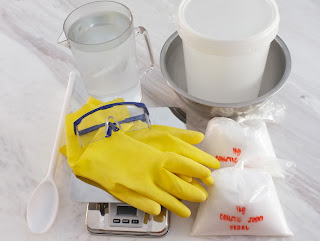Protect Yourself Physically
The most important thing you have to learn about before making soap is lye safety. Because lye can be dangerous if it isn't used properly, it is important to learn as much as you can about it. Before working with your lye, it is imperative to have items that will protect your skin such as long sleeves, thick, plastic kitchen gloves, goggles, and shoes. These will help protect your skin and eye sight in case of accidental spillage.
Mix Lye in a Proper Container
It is also important to mix your lye in the proper container. It is not suggested to mix lye in a metal container. There are a couple of reasons for this. The first being that lye can make the metal very hot and you could potentially burn yourself while handling a metal container. The second reason being that lye can react with certain types of metal such as aluminium and tin. In fact, it would probably be wise to avoid metal all together. A good material to use would be glass. Pyrex glass is an excellent material to use when you are mixing lye. It is also wise to mix with the proper materials. Wood should not be used because lye can break down organic materials. However, metal spoons or whisks are okay to use.
Mix Lye in the Proper Place
You should also be sure that you are mixing your lye in a proper area. Because lye fumes can ben dangerous if inhaled, it is wise to mix lye in a well-ventilated area. If you are mixing lye inside, it is a smart move to turn on a fan and open a few windows. To be as safe as you possibly can though, you could try mixing your lye outside when the weather permits.
Always Mix Lye into Water (Never Water into Lye)
One of the most important things you can do is this: ALWAYS mix your lye into your water, never your water into your lye. This is because mixing water into lye can cause the mixture to explode. The result could be a bad lye burn or even worse.
Store Lye Properly
You should also be sure to store your lye properly when it is not being used. Make sure the container is out of reach of children and pets. Make sure the container is properly labelled so that it is not tampered with.
 |
| This is a chemical burn from lye. |
If Lye Gets on the Skin
If lye comes in contact with your skin it is very important to remove any contaminated clothing. Then wash the affected area with water for at least fifteen minutes and then contact your doctor immediately. Although many soapers believe that you should use vinegar on lye burns, this is not so. Vinegar (an acid) and lye (a base) can cause the burn to feel even hotter and put you in more pain. However, vinegar is good to keep around for the clean up process.
What Happens to Lye During Saponification
Now that lye safety has been discussed, we will be discussing what happens to lye during saponification. Because lye can be so dangerous on its own, many people wonder why on earth we would put it in the soaps that we use on our skin. When you combine fats (an acid) and lye (a base) you get soap (a salt). This process is called saponification. All true soaps are made with lye. That being said, you may be wondering why lye feels so good on your skin. The reason for that is that the lye gets all used up during saponification. It turns the oils and the lye into soap and glycerin.







